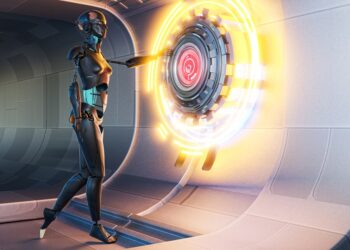Robotics in Healthcare: Advancements and Future Implications
The healthcare industry has undergone significant technological advancements in recent years, with robotics being at the forefront of these developments. Robotics has already transformed several areas of healthcare, including diagnosis, surgery, and patient care, and the technology is expected to continue to play a significant role in the industry’s future. This article explores the current state of robotics in healthcare, the advancements made, and the potential future implications.
Robotic surgery has been one of the most significant advances in healthcare in recent years. This minimally invasive approach has several advantages over traditional open surgery, including reduced blood loss, faster recovery times, and reduced scarring. The da Vinci Surgical System, developed by Intuitive Surgical, is one of the most widely used robotic surgical systems. This system has been used in over six million surgeries worldwide, with over 4,000 installations in hospitals around the globe. The da Vinci system uses a console that is operated by a surgeon to control the robotic arms that perform the surgery. This allows for precise, controlled movements and a high level of accuracy.
Robotics is also being used in other areas of surgery, such as neurosurgery and orthopedic surgery. For example, robots can assist in the placement of implants, which requires precise positioning and alignment. Robotics is also being used to assist with rehabilitation and physical therapy, allowing for more individualized and targeted treatment plans.
Another area where robotics is making significant advancements is in the field of prosthetics. Traditional prosthetics are often uncomfortable and require significant adjustments, but robotics is changing this. Robotic prosthetics are more comfortable, more efficient, and more natural in their movements. They can be controlled by the user’s thoughts, using sensors that are placed on the skin to detect muscle movements. These sensors then send signals to the prosthetic, allowing it to move in response to the user’s thoughts. This technology has been particularly beneficial for amputees, who can now regain a significant degree of independence and control over their movements.

Robots are also being used in patient care, with several hospitals around the world using robotic assistants to help with tasks such as dispensing medication and delivering supplies. These robots can navigate hospital corridors and elevators, reducing the workload on staff and ensuring that patients receive timely care. Robotic assistants can also help with tasks such as lifting and moving patients, reducing the risk of injuries to both patients and staff.
The use of robotics in healthcare is not without its challenges, however. One significant concern is the cost of implementing this technology. Robotic surgical systems, for example, can cost millions of pounds, making them unaffordable for many hospitals. There is also a concern that the use of robotics could lead to job losses, particularly in areas such as patient care, where robots could replace human workers. However, proponents of robotics argue that these technologies can actually increase efficiency and productivity, freeing up staff to focus on other areas of patient care.
Another concern is the potential for errors or malfunctions in robotic systems. Although these systems are designed to be highly accurate and precise, there is always a risk of something going wrong. This is particularly concerning in surgical procedures, where any error could have serious consequences. However, experts argue that the benefits of using robotics in surgery outweigh the risks, particularly when it comes to reducing the risk of complications and improving patient outcomes.
Looking to the future, robotics is expected to play an even greater role in healthcare. One area where robotics could be particularly beneficial is in the field of telemedicine. Telemedicine allows healthcare professionals to connect with patients remotely, using video conferencing and other technologies. This is particularly useful for patients who live in remote areas or who are unable to travel to a healthcare facility. With the use of robotics, healthcare professionals could perform remote examinations and even carry out minor procedures, providing patients with access to healthcare that would otherwise be unavailable. For example, a robotic system could be used to perform a virtual colonoscopy, allowing patients to undergo the procedure without the need for invasive surgery.
Robots could also be used in the development of new drugs and treatments. With the use of artificial intelligence and machine learning, robots could be used to analyze vast amounts of data and identify potential drug targets or treatment options. This could significantly speed up the drug development process and lead to the development of more effective treatments.
Another potential application for robotics in healthcare is in the field of mental health. Robots could be used to provide counseling and support to patients with mental health conditions, offering a non-judgmental and confidential environment for patients to express their feelings and concerns. The use of robots could also help to reduce the stigma associated with mental health conditions, as patients may feel more comfortable speaking with a robot than a human counselor.
Conclusion
The use of robotics in healthcare has already transformed several areas of the industry, from surgery to patient care. The benefits of this technology are clear, with reduced complications, faster recovery times, and improved patient outcomes. However, there are also challenges that need to be addressed, such as the cost of implementing this technology and the potential for errors or malfunctions. Looking to the future, robotics is expected to play an even greater role in healthcare, with the potential to revolutionize the way that healthcare is delivered. It is clear that robotics has the potential to significantly improve patient outcomes, and it will be exciting to see the developments in this field in the years to come.
One of the most significant advantages of robotics in healthcare is the potential to reduce the workload on healthcare professionals. With the use of robots for tasks such as dispensing medication and delivering supplies, healthcare professionals can focus on more complex and specialized tasks, such as diagnosis and treatment. This could help to alleviate some of the strain on healthcare systems, particularly in areas where there is a shortage of healthcare professionals.

However, there is also a concern that the use of robots could lead to a loss of the human touch in healthcare. Patients often value the personal connection that they have with their healthcare providers, and some may be hesitant to interact with robots. It is therefore essential that robotics is used in a way that complements the work of healthcare professionals, rather than replacing it entirely.
There is also a need for careful consideration of the ethical implications of using robots in healthcare. For example, there may be concerns about the use of robots in end-of-life care, where patients require a high level of human interaction and empathy. There is also a need to ensure that the use of robots in healthcare does not reinforce existing inequalities, such as those based on income or geography.
Despite these challenges, the potential benefits of robotics in healthcare are significant. The use of robotics has already transformed several areas of healthcare, and the technology is expected to continue to evolve and improve in the years to come. With the use of robotics, healthcare professionals can provide more efficient and effective care, while patients can benefit from faster recovery times and improved outcomes.





















